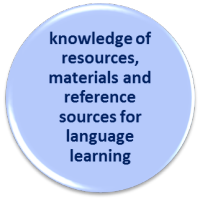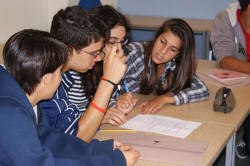Delta Module One Course
 |
Syllabus area 5
|
 |
This section of the syllabus covers these two areas and you should be able to:
|
To be able to do this you need a knowledge of these areas. The guides linked below are those on this site which cover the areas. You should follow those and then return to this page to try some tests of your knowledge.
 |
An overview of what you need to know |
Before you start, it is useful to consider what the
terms Critically evaluate
and Identify and evaluate
mean.
Click here when you have done that.
- Critically evaluate
- This is much more than simply saying
This is good
That is OK
This is unusable
etc.
Critical evaluation involves considering the targets of materials and exercises as well as understanding the needs of the learners.
It also requires you to identify the underlying premises concerning how the authors understand language and believe language is learned. For this area, see the parts in this course on theoretical perspectives and approaches and methodologies. - Identify and evaluate
- This does not mean the same thing. Here, you are being
asked to focus on the practical use of the materials.
That's identification of purpose.
Evaluation involves understanding what theories of language and language learning underlie the design of the materials and, given the target audience for them, deciding (i.e. evaluating) how useful and effective they are likely to be.
 |
The examination tasks |
If you have followed, as you should have, the first two areas of
this course, you will know that one examination task in particular
(Paper 2, Task 2) requires you to surmise the materials writer's
underlying assumptions which influenced the design of teaching
materials.
That task also requires you firstly to identify what the material is
intended to achieve and how it combines (i.e., is linked and sequenced) and
then evaluate its effectiveness.
This is also, therefore, where your knowledge of how to evaluate the
fitness of materials for their ostensible purposes is tested.
We will not be focusing here on recognising the author's theoretical
assumptions because we have done that and been there. The
examination practice materials, however, consider this, too.
 |
The learners |
Frustratingly, you will be told very little about the intended audience for the materials presented in the examination paper. Part of the rubric for the latest published paper (2015) simply states, for example:
The purpose of the extract as a whole is to enable learners to express obligation and permission.
but is unhelpfully silent concerning what kind of students, learning
for what purposes, where. It also doesn't help that the terms
obligation and permission are loose to the point
of meaninglessness. However, ...
What you need to do, therefore, is look at the material as a whole
and focus on the choice of topic and the types of activity.
That will tell you a good deal about the intended audience in terms
of age and interests.
Materials which are directed at specific learning purposes will be
unlikely to occur so you are going to be focused on general English
learners of indeterminate age (although materials intended for young
children are also unlikely to be the subject of the task).
 |
Purposes and connections |
Because it is unlikely that you have ever used the materials,
what you are obliged to do here is perform a prospective evaluation
of the materials and infer (or plain guess) from the topics and
layout what the intended audience is.
Usually, the rubric for the task will be something like:
Identify six purposes of the exercises listed in the box below in relation to the purpose of the extract as a whole.
which is simple enough and makes clear by implication:
- You will gain no marks if you identify more than six purposes.
- You need to bear in mind what you have been told about the overall purposes of the material so, if, for example, there is some peripheral skills work in material intended to teach and practise systems, that should not be focused on because it is not included in the overall purpose of the material. There will always be some incidental and marginal work in any set of materials.
 |
Purposes and targets |
In order to have some consistent framework for your answer, you should consider the three fundamental types of task that most materials contain. Not all these types of task will be present in any extract you are given but you need to look out for them:
- Awareness raising

These tasks usually come at the beginning of a teaching unit but may recur in later parts if the focus is shifting. They do not usually ask the learners to use the target language.
The majority of these tasks are prospective, looking forward to the main targets of the materials.
Such tasks may also be retrospective so, for example, a text may be read for general meaning before the materials require the learners to go back to it and notice certain language or organisation features.
Purposes for such tasks include:- Schema(ata) activation:
getting students to access and refresh their memories concerning what they know of the topic and the language. Such tasks often involve listing or prioritising, exchanging ideas with a partner, reflecting on the content of images and so on. - Focusing:
to make the learners aware of the target(s) of the materials so they bring their own knowledge and experience to the lesson. These tasks can often be identified as noticing tasks with highlighted pieces of written texts or listening / viewing tasks in which the learners are asked to notice certain elements of the language only.
- Schema(ata) activation:
- Skill getting

The term skill here is used in its widest sense. It may be a language skill or subskill (related to reading, listening, speaking or writing) or the focus may be on acquiring the forms of the language and relating them to the functions they realise. It may also be a notional exercise enabling learners to talk about concepts. All these can be considered skills as far as the material's purposes are concerned.
The majority of such tasks are controlled, some quite strictly, others less so but an element of control is almost always present.
Purposes for such tasks include:- providing exemplification of language items before controlled practice
- controlled practice to allow the learners to focus tightly on the target(s) and also allow the teacher to judge how well they can use the subskill(s) or manipulate the form(s)
- mechanical drilling to consolidate form and shape pronunciation
- contextualising the language so that the learners see its communicative function and have some idea of any stylistic constraints
- checking understanding of the communicative effect of the language
- contrasting new language and skills with already mastered language and skills so that the learners can make connections and extend their repertoire
- providing models on which to hang the language to aid retention
- Skill using

These tasks usually follow the skill-getting tasks and are designed to consolidate the language or skill use and to give the learners the opportunity to personalise it. These tasks also provide everyone, teachers and learners, with the chance to see how well skill-getting has worked.
These are normally somewhat freer activities.
Purposes for these tasks include:- personalisation: getting the learners to use the language in a way that is meaningful and memorable for them.
- extending: driving the language or skill beyond the confines of the presentation and practice stages to make it more widely relevant and applicable.
- encouraging autonomy: allowing the learners to see the relevance of the skill they have acquired beyond the classroom and the topic area focus of the materials.
- revisiting production: to allow the learners to refine and improve their own initial attempts during the skill-getting phases.
- providing a change of focus and some light relief: to enhance motivation and engagement.
The key terms you need to think about employing in this task are almost all verb phrases:
| Awareness raising | Skill getting | Skill using |
| raise activate notice recall remember consider think about focus brainstorm |
remember focus provide examples / models practise drill contextualise check assess contrast |
personalise encourage revisit revise refine improve use extend change focus |
 |
Connections |
Again, you are asked to identify only six connections. Doing more will gain you nothing and just waste time.
To do this task, focus on the language in the materials. If, for example, you come across any of the following, it is a sure sign that there is an explicit connection. Do this first before you try to see what is implicit – you may even find six explicit connections.
| look back refer to look again compare |
listen again read again Now, ... When ... |
Next, ... review choose two of ... select |
All these instructions strongly imply a connection with what has
gone before.
Look, too for any repetition of language because that is a sure sign
that something is being connected and extended.
You are also required to comment on the connections but this need
not be very lengthy. It is the identification that matters
most.
It is enough to say, for example:
- This task links to the opening text and encourages the learners to notice the important auxiliary verbs.
- Exercise 5 gets the learners actively to produce the language in Exercise 3 and focuses on its pronunciation. It is intended to recycle the material to place it in the learners' long-term memory.
- The final task is to deploy the language presented in Exercises 3 and 6 in a personal way, aiding recall and making progress clear and assessable. It is intended to move the items from the passive to active language knowledge of the learners.
and so on.
 |
The next steps |
If you have not already done so, and you have the time, following the guides in this list will help with the first two parts of Task 2 Paper 2. (The third part, in which you identify underlying assumptions has been covered elsewhere.)
| Culture and learning styles | a guide to how these two factors may impinge on materials design |
| How learning happens | especially the last part on factors affecting learning |
| Noticing | a relevant area which will alert you to the purposes of many tasks |
| Task types | a guide awareness-raising, skill-getting and skill-using tasks |
| Activity types | a connected guide |
| Ten types of resources | a run-down of ten types of classroom resource discussing what they are and what they are useful for |
| Authenticity | to help with identifying what is and is not authentic |
 |
Where next? |
Now it's time to test your knowledge in these areas and then do some revision exercises.
Here are the choices:
| A set of tests | to check what you can remember. Do these first. |
| Revision course index | there is a section of the Delta Module One Revision Course for this area of the syllabus |
| Examination practice | apply the knowledge you have gained to practising for the examination (new tab) |
 |
 |
| course index | exam practice |
